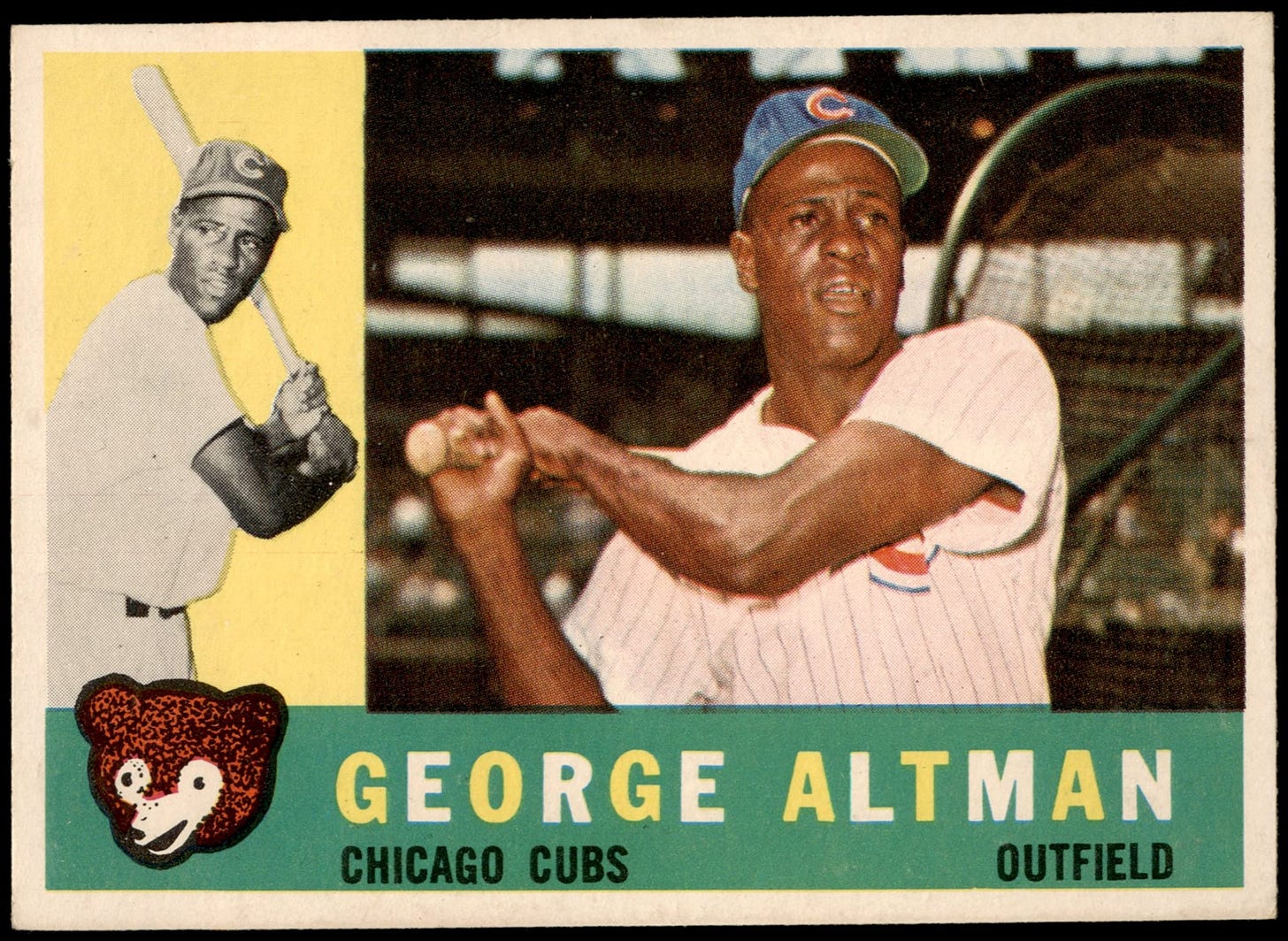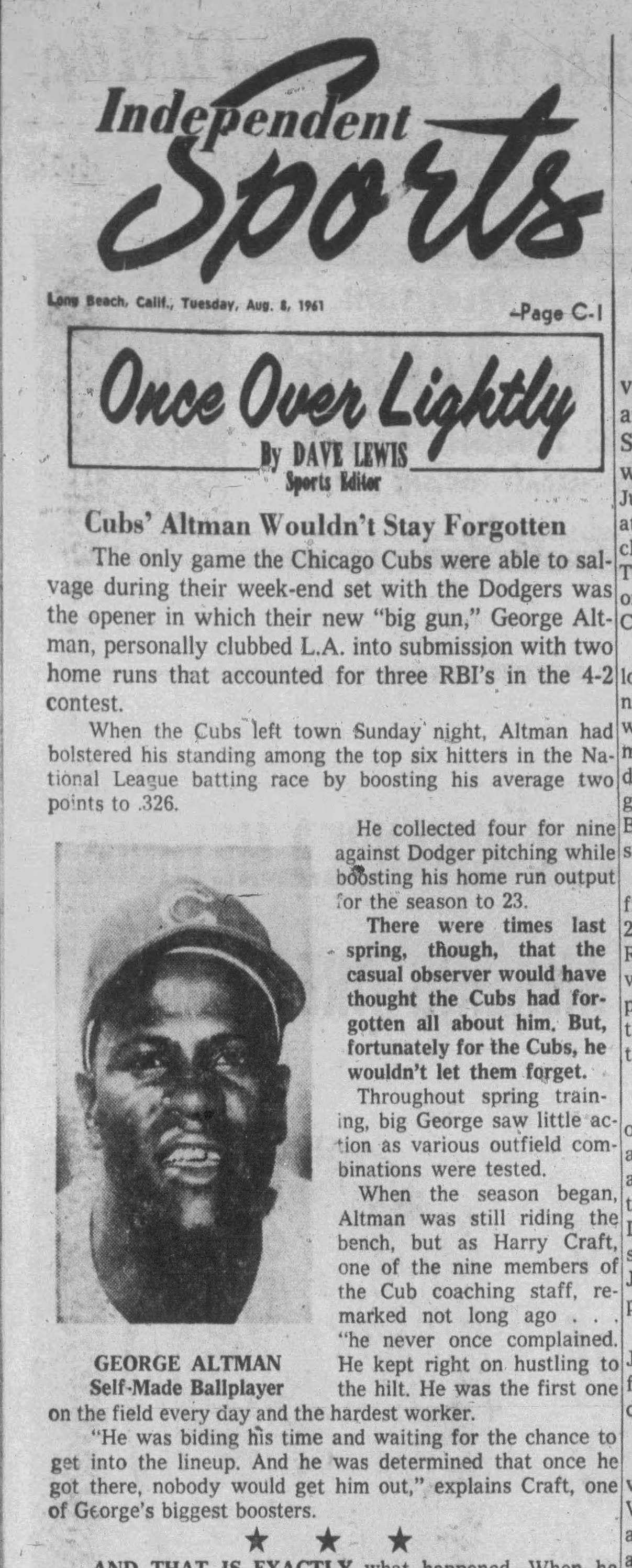March Madness Moments: Chicago Cubs All-Star George Altman & A Groundbreaking Basketball Program
A unique athlete contributed to one of college basketball's most influential programs of all-time.
The first installment in The Press Break’s second edition of March Madness Moments actually begins with an August day — and with news from the baseball world.
At the end of the eighth month in 1955, Major League Baseball’s Chicago Cubs announced the signing of three prospects from the Negro League’s Kansas City Monarchs. Chicago had previously signed a shortstop named Ernie Banks from the KC club, and you could say things were going pretty well: Banks was amid a 44-home run, 117-RBI season and the first of eight consecutive All-Star selections in 1955.
Headlining the next class of Monarchs alumni to follow Banks to the Cubs organization was George Altman, a future two-time All-Star in Chicago. Altman’s tenure on the North Side included a 1961 in which he hit .303 with 27 home runs and a league-leading 12 triples.
The next season, Altman hit .318, homered 22 times, and stole 19 bases.
But before George Altman embarked on a Major League career that lasted until 1967, and a professional baseball career that spanned until 1975 when he retired from Japan’s Pacific League with a then-American record 205 homers, he was a standout college basketball player at one of the sport’s early dynasties.
In fact, the wire report from August 1955 announcing the Cubs’ signing of Altman prominently mentions the 6-foot-4 prospect’s basketball exploits. Decades later, his overall career has been the subject of far more thorough examinations than I’m prepared to provide here. For more on his multiple-sport career and world travels as a baseball player, I recommend this MLB.com piece.
But as for George Altman’s time in college basketball specifically, the role that he had on a program that was transcendent and transformative is fascinating to piece together through accounts of the time.
In 2024, following Grambling’s historic NCAA Tournament win over Montana State, March Madness Moments spotlighted Tigers alum Willis Reed and Grambling’s national championship-winning team.
Madness Moments: Willis Reed Is Smiling
Grambling State clinching the win in its first-ever NCAA Tournament on a rebound is perfect.
The same year that Altman had Cubs fans chanting “Let George Do It!” — it being to claim the National League batting crown — Reed powered Grambling to the fourth of five HBCU NAIA titles in a six-year span.
Ushering in that era of HBCU excellence were luminary coach John McClendon and his three-peat Tennessee A&I teams of 1957, 1958, and 1959. The Tigers’ monopoly of the NAIA title marked the culmination of a sensational decade for the program, even predating McClendon’s arrival for the 1954-55 season (which was George Altman’s senior campaign).
McClendon’s tenure was the peak for what is now Tennessee State, reflected in modern times with the entire 1957-1959 rosters receiving enshrinement in the Basketball Hall of Fame.
The program’s championship foundation was laid throughout the '50s leading up to its three-peat, including a breakthrough 1953.
It was in that season, as a sophomore, that Altman contributed to Tennessee A&I’s first-ever NAIA Tournament appearance. What’s more, the 1953 Tigers were the first HBCU representatives invited to the NAIA Tournament.
And this particular NAIA Tournament was staged a full decade before the milestone Game of Change between Loyola and Mississippi State in the 1963 NCAA Tournament. For a “Negro College,” as newspapers of the time described Tennessee A&I, to play and beat opponents Geneva and St. Benedict’s was a moment of its own major cultural significance.
The Tigers opened the 1953 NAIA against Geneva from Pennsylvania, and Tennessee A&I outlasted the Golden Tornadoes in an 89-88 nail-biter. Geneva rallied from a 68-48 deficit in the second half behind a 43-point performance from Richard “Pete” Kinkead.
Kinkead’s outpouring is legendary enough in Geneva history that his Hall of Fame bio on the school’s official athletic website references the game specifically. However, Tennessee A&I’s balance — which included four points from Altman — outpaced the Golden Tornadoes.
Altman scored eight points in the next round, a blowout of St. Benedict’s. The Kansas-based school won the NAIA national championship the next season.
And while Tennessee A&I bowed out in the next round against East Texas State, the prominent Kansas City-based Black-owned newspaper The Call published a tremendous spread from the game, highlighting the unifying spirit of this matchup.
George Altman’s final college basketball game came in March 1955, and it wasn’t at the NAIA Tournament. With only one bid to be had among the Southern HBCU programs, inclusion in the 1955 field came down to an end-of-season showdown between Tennessee A&I and Texas Southern.
Within weeks of his Tigers basketball career ending, Altman debuted with the Kansas City Monarchs. Five months later, he was a Chicago Cubs signee.
Another 59 years after, George Altman led Wrigley Field in “Take Me Out to the Ball Game.”








